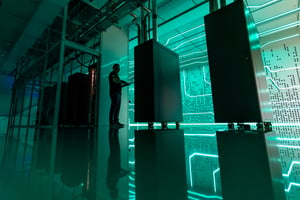AI Data Centers: A Power Surge Looms
As artificial intelligence continues its rapid evolution, the demand for data center electricity is projected to skyrocket. Recent research from Deloitte predicts a staggering increase from 4 gigawatts today to 123 gigawatts by 2035. However, this astronomical growth faces daunting obstacles that could stifle the technology’s potential.
Timing is Everything
One of the most pressing challenges is timing. Constructing data centers can typically be accomplished in one to two years. Yet, the associated power infrastructure, particularly gas power plants, will take longer to be operational, especially where new equipment isn’t already ordered. Reports suggest that grid connections in some areas face delays of up to seven years. This disconnect places immense pressure on companies to plan beyond immediate needs.
Kelly Marchese, a Deloitte infrastructure specialist, emphasizes, "These are major investments that require planning well beyond just a few years." It’s clear that organizations need to think strategically about the future while making these significant investments.
Labor and Collaboration Shortages
The industry isn’t just grappling with timing issues; there’s also an acute skills shortage. Approximately 63% of data center executives report labor shortages as a top concern, exacerbated by competition for specialized workers from various sectors.
Furthermore, cooperation between data center operators and power utilities is alarmingly ineffective. Only 15% of data center leaders describe their partnerships with power companies as highly effective. This lack of synergy complicates the tackling of grid capacity challenges, which both groups agree are critical.
Supply Chain Struggles and Investments
Supply chain bottlenecks pose another layer of difficulty. The cost of construction materials has surged by 40% over the past five years, impacting project timelines. Additionally, tariffs and import dependencies on essential components cause potential delays in infrastructure development.
In response to these challenges, utilities and hyperscaler companies are planning to invest significantly—over $1 trillion each—in infrastructure over the coming years. The tech industry is also stepping up, earmarking more than $1 trillion for U.S. manufacturing of AI supercomputers, chips, and servers.
Cybersecurity and Regulatory Hurdles
The rapid growth of AI data centers is also generating cybersecurity concerns. These facilities are increasingly seen as attractive targets for cyberattacks, raising alarms about their vulnerability to supply chain threats.
Moreover, the regulatory environment is struggling to keep pace with the burgeoning demand. Delays in environmental impact assessments can lead to lengthy wait times—more than two years in some cases—stymying progress on necessary projects.
A Ray of Hope: The Role of AI
Interestingly, AI itself may provide solutions to some of these infrastructural challenges. A significant 83% of survey respondents anticipate that grid-enhancing technologies will be pivotal in meeting future energy needs. Additionally, 68% believe that demand flexibility will become an acceptable compromise for faster grid connections.
Marchese notes that this crisis may catalyze unprecedented collaboration among historically siloed industries. "Utilities and hyperscalers are having to solve some of these problems together," she explains, hinting at potential innovations that could reshape infrastructure building.
In conclusion, the road ahead for AI data centers is complex, filled with both challenges and opportunities. As organizations navigate these hurdles, the landscape may evolve to foster more collaboration, potentially setting a new standard for how vital infrastructure is built and managed in the age of AI.

Writes about personal finance, side hustles, gadgets, and tech innovation.
Bio: Priya specializes in making complex financial and tech topics easy to digest, with experience in fintech and consumer reviews.

